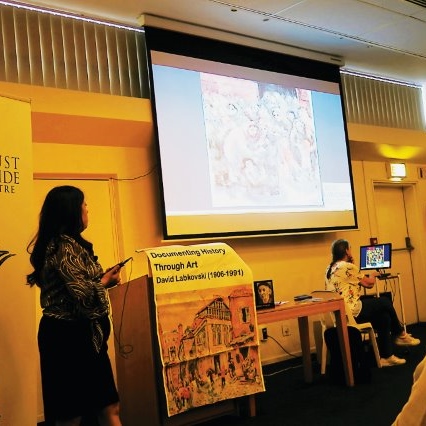
News

Stepping into a Holocaust painting via virtual reality
TALI FEINBERG
“To improve the impact of Holocaust education, we need to understand the vast Jewish life that existed beforehand, and how Jews have lived for centuries,” said Leora Raikin, the director of the David Labkovski Project, in a presentation to the Cape Town Holocaust & Genocide Centre. A native of Cape Town, Raikin lives in Los Angeles and uses her great uncle’s vast body of artworks to educate people around the world about the Shoah.
“You will wear special glasses to step into the art and become part of the painting. We utilised the skills of a gaming designer to bring these pictures to life. The script comes from testimonies of Jews who lived in Vilna and survived the Shoah. You will be able to walk around the house, light candles, pour water, pick up the challah … even pet the goat! You’ll be able to go into the Vilna marketplace and experience everyday life. Studies show that 20 minutes of virtual reality is equal to a three-hour lecture in terms of learning,” said Raikin.
She said her great uncle’s vivid paintings were up on the walls of her grandparents’ home in Sea Point, so his art has always been part of her life. Labkovski was born in 1906 and raised in Vilna, which at that time was the centre of the Jewish world. All he wanted to do was paint and draw, and he went on to work at the prestigious State Jewish Theatre in Moscow before being accepted as one of 500 applicants at the Art Academy of Leningrad.
It was there that he learnt everything about being an artist, from mixing paints to anatomy and architecture. But it all came crashing down when Stalin rose to power, arresting anyone suspected of anti-Soviet activity. Labkovski was imprisoned in solitary confinement for 10 months and then sent to Siberia. His future wife, Rivka Spektor, was also sent there. “The fact that many Jews survived the Holocaust because they were sent to Siberia is one of the greatest untold stories of this era,” says Raikin.
But Labkovski told the story through his art. His paintings depict the horrors of life in the gulag – sub-zero temperatures, starvation, slave labour, and a brutal existence. They form part of the small archive of documentation by those who were there. Labkovski survived because he became a tattoo artist for rival gangs and painted portraits.
But that wasn’t the end of the story. When he returned to Vilna after the war, the world as he knew it had vanished. Ninety five percent of the Jews in the city had been murdered, including Raikin’s great grandparents, great aunt, and her five-year-old twins. Most had been shot in the nearby Ponar forest. Jewish life that had existed for 500 years had ended.
Yet it lived on in Labkovski’s paintings. He began to paint everything he remembered about Vilna – from the family home to the marketplace. These are the paintings that will now be explored in virtual reality, which Raikin hopes will be ready within the next year. He also depicted Jews being persecuted, forced to wear yellow stars, and eventually being led to their deaths, imagining in horrifying detail what happened to his family and community.
Labkovski’s life continued on a tragic path that echoed the events of the 20th century. He and Rivka fled Vilna, which was now communist, with a few paintings and silver spoons (Raikin was eventually given one of these silver spoons as a wedding gift). They settled in Tsfat in Israel where they exhibited the paintings, but they were not well-received by the Israeli public, which was not ready to look back on what had been lost.
The couple were not able to have children, so they kept the paintings as a complete collection, almost like their own “children”. When they passed away in the 1990s, much of the art was looted and stolen. It turned into a 22-year-long court case that eventually reached Israel’s Supreme Court. Eventually, some of the art was recovered and divided up amongst the family. Although they appreciated the art, it was mostly stored away from the public eye.
One day, upon telling friends about her great uncle, Raikin realised she had to use this art to educate others about the Holocaust. She founded the David Labkovski Project, which now travels the world educating schoolchildren, adults, and professionals. The project is unusual in that it allows participants to make their own exhibitions of the work, therefore becoming curators and docents of these exhibits. “In turn, they teach their own communities,” she said.
Raikin said that as soon as this responsibility is given to pupils, they absorb knowledge and lessons that might otherwise pass them by in traditional classrooms. “It’s multi-disciplinary and non-judgemental. Art is universal – anyone can access it,” said Raikin. She hopes to eventually train teachers in the programme. The original art has also been exhibited in Lithuania – taking it “home” to the place it originated from.
The virtual reality aspect of the project is time consuming – it’s a 15-minute experience and can be experienced by only one person at a time. But whenever Raikin has presented it, there have been lines of people waiting patiently to try it. People are so interested in it, she believes, because “art is universal, it is multi-disciplinary, it appeals to kids and adults, and it explores life before, during and after the Holocaust. Ultimately, this is the future of learning.”




